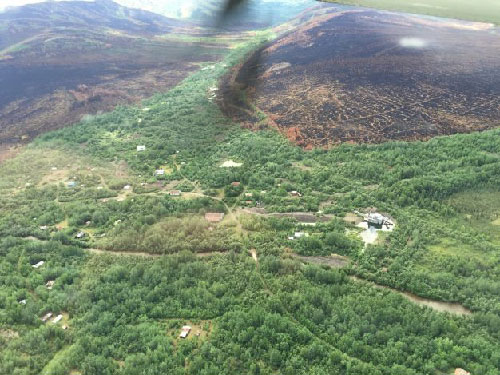
Historic Iditarod, Flat gold rush townsites saved from recent wildland firesJuly 25, 2015
Mushers won’t be able to tell how close a wildfire came to wiping out the checkpoint that bears the race’s name and marks the halfway point in the famed 1,000-mile sled dog race from Anchorage to Nome.
Iditarod townsite saved from fire
The smokejumpers immediately went to work, conducting burnout operations linking ponds and river channels surrounding the town. The burnouts robbed the larger fire of fuel, and successfully halted the fire less than a mile from the townsite. The smokejumpers spent the next three days conducting burnouts and doing site protection around structures, including two buildings that serve as headquarters for race personnel and mushers during the race. The end result is that all the buildings were saved and now stand in an island of green surrounded by miles of charred tundra. “Thankfully those buildings are still intact,” said Iditarod executive director Stan Hooley. “I saw aerial photographs of the burn and it’s apparent to me they did a remarkable job to protect that area.” The Iditarod Trail Committee built one of the structures that was saved and refurbished another that the race now uses, Hooley said. Had the buildings been destroyed, it would have meant rebuilding or using tents to house race staff and mushers. “It’s not like any of the other communities or villages the race passes through, where there might be another building we can use,” Hooley said. One of the most remote checkpoints of the race, Iditarod is located in a vast, roadless area 90 miles southwest of McGrath. “It would have put us in a bit of a box in terms of having to rebuild.”
Flat gold rush townsite One day after fire nearly destroyed Iditarod, and eight miles to the south, smokejumpers and a Type 2 initial attack crew from Kentucky also successfully protected the gold rush town of Flat, its historic structures and a number of active mining claims. Unlike the ghost town of Iditarod, which is largely uninhabited except during the Iditarod race, Flat is home to a handful of seasonal inhabitants with active mining claims and a number of historic structures from the gold rush era. Both Flat and Iditarod are eligible for listing in the National Register of Historic Places. The two towns sprouted after gold was discovered in a tributary of the Iditarod River in 1908. Iditarod quickly became a bustling boomtown complete with hotels, cafes, brothels, three newspapers, a bank, a mercantile store, electricity, telephones, automobiles and a light railway to nearby Flat, which started out as a small camp but quickly blossomed into a thriving community. By 1914, the town of Flat boasted a population of about 6,000 people with an elementary school, telephone system, two stores, a hotel, restaurant, pool hall, laundry and jail. Many of the buildings in Flat were moved there from Iditarod by miners. By 1930, however, the gold rush was over and population of Flat had declined to about 120. Iditarod, meanwhile, was left a ghost town. The quick action taken by the Division of Forestry and firefighters to save the two historic sites that hold a special place in Alaska history deserves recognition, said Kevin Keeler, coordinator for the Iditarod National Historic Trail for the Bureau of Land Management in Alaska. “These ghost towns were home to America’s last great gold rush, reflecting the days when pioneers used dogsleds and steamboats to supply boom towns and access the gold fields,” said Keeler, who flew over the area last week with State Forestry officials. “Both are national significant and the townsite of Iditarod is legally protected by the State of Alaska. Given that these sites are literally in the middle of nowhere, saving these places is fantastic.”
Edited by Mary Kauffman, SitNews
Source of News:
|
||

